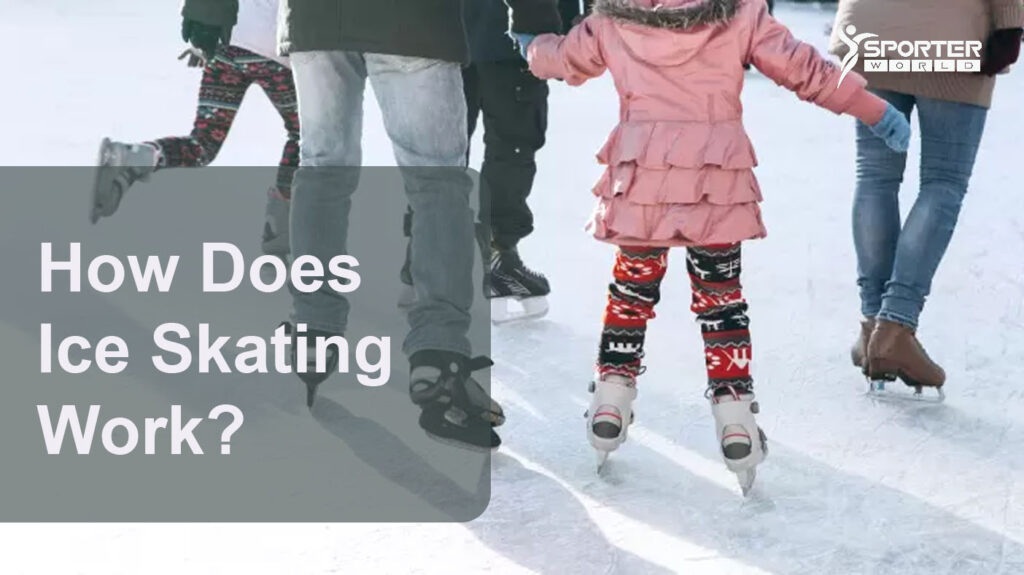Do you love figure skating and want to be able to glide on the ice effortlessly? Anyone can learn to ice skate with the right guidance. This article will help beginners start ice skating. So, lace up your skates and get ready to glide like a pro!
Ice skating is a fun and exhilarating sport that offers a great workout. But where do you begin? Find a nearby ice rink and check their schedule for public skating sessions. After securing a spot on the ice, learn the basics like balancing, gliding, and stopping. You can skate confidently with practice and patience.
In this article, we’ll break down the learning process of ice skating into easy-to-follow steps. From choosing the right equipment and gear to mastering the fundamental skills, we’ll provide you with all the necessary information to help you become a proficient ice skater. So, let’s delve into the exciting world of ice skating and start your journey to becoming a skilled skater.
How Does Ice Skating Work?

The secret of ice skating lies in the physics behind the low friction of ice. For many years, experts have wondered why a relatively thin blade in an ice skate could so effortlessly glide across an icy surface. One popular theory suggests that it is because pressure from the blade melts the ice under it, producing just enough water to reduce the friction between the skater and the surface.
As anyone who has ever made a snowball can attest, snow can become liquid when subjected to high enough pressure. This means that if the same thing were to happen with a pair of blades on an ice rink, they would be able to generate enough force for just enough water to make it possible for someone to skate quickly and gracefully.
However, this is not always what causes skaters to slide so well, as another popular theory explains that the surface’s smoothness contributes significantly more than pressure does in reducing friction. Upon closer examination of an outdoor rink or natural frozen pond, one will notice numerous small bumps on its surface – these are caused by tiny snowflakes which themselves melt slightly and freeze back up again multiple times a day due to temperature fluctuations. Over time, these micro-bumps create a smooth texture on top of which
You Also May Like: Midwestern Sectionals Figure Skating
Why Should You Learn Ice Skating?
Ice skating is one of the best forms of exercise you could choose. It requires full control of your body and legs for controlling movements, drive, and speed. The constant movement works wonders for your cardiovascular system and weight management—just an hour of ice skating can burn up to 850 calories. You’ll feel your calves, hamstrings, and core muscles burning as you hit the ice. Additionally, this activity improves your upper body flexibility, balance, coordination, and posture and increases your endurance when executed regularly.
Aside from the physical benefits of regular ice skating, it brings together people of all ages and fitness levels to have fun with ice sports and build a community sense. Whether attending a hockey game or carving in circles around the rink, you’ll leave feeling happier than when you first stepped onto the icy surface! With determination and dedication in learning technique–ice skating is an unbeatable way to get moving. This fun exercise routine is worth picking up with its positive mood-boosting properties.
Why do I need To Learn Skating?

Ice skates are the most essential tool for learning how to ice skate or participating in any form of ice skating sporting activity. You must find a pair of skates that fit comfortably and securely, as they will be your main source of stability on the ice. In most cases, you can rent skates from your local rink or sporting goods store. But if you plan on skating long-term, investing in a pair may be the way to go.
Each sport has different types of ice skates, so you must purchase the correct type for your desired activity. For example, if you‘re interested in hockey skating, there are special types of hockey skates made especially for such activities which offer extra support and protection due to their durability and ankle-supporting design. Conversely, figure skating calls for lighter-weight boots and thinner blades, allowing easy maneuverability on the ice. Whatever type of skate you choose depends entirely upon what kind of sport or event you wish to participate in.
Here Is How to Learn Ice Skating:
- Getting on the ice safely: Skaters are advised to look left and right to check for other skaters before stepping onto the ice.
- Learning how to fall: Skaters are encouraged to sit down when losing balance, as if sitting in a chair. They are reminded that falling is a normal part of learning and not something to worry about. To get back up, they should roll onto their side, get onto their knees, put both hands up in the air, step onto one foot, and push off the knee to stand up.
- Proper stance and posture: Skaters are instructed to bend their knees even more than they think, ensuring their shoulders are over their knees. They are reminded to keep their eyes looking straight forward rather than down at the ground.
- Marching: Skaters are encouraged to lift one foot at a time in a marching motion, first in place and then moving forward.
- Gliding: Skaters are taught to push off with the inside edges of their feet, creating a pizza shape with their feet. They should feel like they are pushing out and slightly to the side or back.
The guide emphasizes the importance of practice and encourages skaters to have fun while learning to skate safely.
What Safety Gear Do I Need To Learn Ice Skating?

When learning to ice skate, it is recommended to wear the following safety gear to protect yourself from potential injuries:
- Helmet: Wearing a helmet is crucial for protecting your head from any falls or collisions. Choose a helmet specifically designed for ice sports, such as ice hockey or ice skating helmets, which provide appropriate protection.
- Knee Pads: Knee pads help cushion and protect your knees from impact during falls or when landing on the ice.
- Elbow Pads: Elbow pads provide padding and protection for your elbows in case of falls or collisions with other skaters or objects.
- Wrist Guards: Wrist guards support and protect your wrists, which are vulnerable to injury when falling forward and landing on your hands.
- Gloves: Wearing gloves keeps your hands warm and provides some protection in case you use your hands to break a fall.
- Thick Socks: Wearing thick, comfortable socks helps provide cushioning and insulation for your feet inside the skates.
While not mandatory, wearing these safety gear items can significantly reduce the risk of injury while learning to ice skate. It’s important to ensure the safety gear fits properly and securely fastened before getting on the ice. Additionally, follow the guidelines and safety instructions the skating rink or instructor provides.
Tips To Learn Faster
If you’re looking to learn ice skating faster, here are some tips to help you progress more efficiently:
- Take lessons: Enrolling in ice skating lessons, either group or private can provide structured guidance from a trained instructor. They can teach you proper techniques, help correct your form, and provide valuable feedback to accelerate your learning.
- Practice regularly: Consistency is key. Try to practice ice skating regularly, even if it’s just for short sessions. Regular practice allows your muscles to develop the strength, balance, and coordination required for skating.
- Warm up and stretch: Before getting on the ice, warm up your body with some light exercises and stretching. This helps to prevent injuries and prepares your muscles for the physical demands of skating.
- Work on balance and core strength: Skating requires good balance and core stability. Incorporate exercises that improve your balance and strengthen your core muscles, such as squats, lunges, and balancing drills.
- Start with basic movements: Master the foundational skills before moving on to more advanced techniques. Work on basic movements like marching, gliding, and stopping to build a solid foundation for your skating skills.
- Focus on proper technique: Pay attention to your body positioning, weight distribution, and blade control. Practice proper posture, keeping your knees bent, shoulders over your knees, and looking forward. Learning and maintaining good technique from the beginning will help you progress faster in the long run.
- Learn from others: Watch experienced skaters and observe their techniques. Study online tutorials, videos, and demonstrations to learn new skills and understand proper form. You can also learn by skating with others who are more advanced than you, as their skills and movements can inspire and motivate you to improve.
- Challenge yourself gradually: As you gain more confidence and skill, gradually challenge yourself with new movements and techniques. Set achievable goals and progressively work towards them. Pushing yourself out of your comfort zone a little at a time will help you progress faster.
- Stay positive and patient: Learning to ice skate takes time and practice. Be patient with yourself, celebrate small victories, and don’t get discouraged by falls or setbacks. Stay positive, have fun, and enjoy the learning process.
Remember, everyone learns at their own pace, so be patient with yourself and enjoy the journey. You’ll improve your ice skating skills with practice, determination, and a positive mindset over time.
Frequently Asked Questions
1. How long does it take to learn how to ice skate?
The time it takes to learn how to ice skate can vary depending on age, physical fitness, and previous experience with similar activities. While beginners can start feeling comfortable on the ice within a few weeks to a few months with regular practice and proper instruction, becoming proficient and confident in more advanced skills may take several months or even years of dedicated practice. It’s important to remember that learning to ice skate is continuous, and progress varies from person to person. The key is to enjoy the journey and embrace each milestone.
2. What are some common tips for improving balance on the ice?
Improving balance on the ice is crucial for successful skating. It’s important to focus on a few key tips to enhance your balance. Bend your knees slightly to improve stability. Strengthening your core muscles improves balance. Keeping your body aligned with shoulders over knees and head up with eyes forward maintains balance and posture. Balancing exercises off the ice can improve your balance and stability on the ice.
3. How can I overcome the fear of falling while ice skating?
Fear of falling is a common concern when learning to ice skate. However, there are strategies to help overcome this fear. Wearing safety gear can make you feel safe and prevent injuries. Learning to fall properly reduces fear. Practicing falls builds confidence and shows that falling is normal in learning. Start slow, master the basics, and gain confidence as you progress. A qualified instructor can help you navigate the ice safely.
Conclusion
Learning to ice skate takes practice, determination, and a positive attitude. Whether you’re just beginning to learn the basics or want to improve your skills further, there are many ways to develop your ice skating abilities. Watch experienced skaters, challenge yourself gradually, stay positive and patient, and use safety gear to reduce the fear of falling. With these tips in mind, you can become an expert skater in no time. Good luck!




